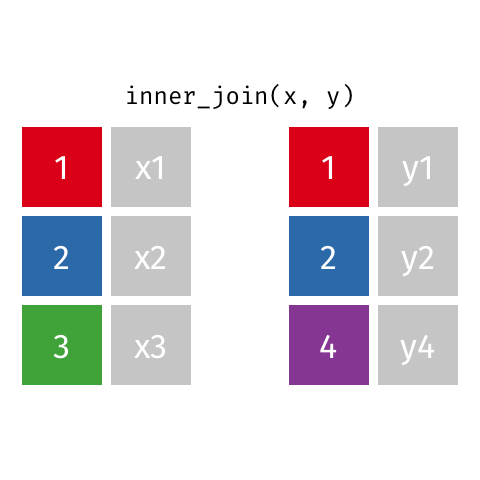Setup
install.packages('dplyr')
download.file("https://ndownloader.figshare.com/files/2292172", "surveys.csv")
download.file("https://ndownloader.figshare.com/files/3299474", "plots.csv")
download.file("https://ndownloader.figshare.com/files/3299483", "species.csv")
download.file("http://www.datacarpentry.org/semester-biology/data/shrub-volume-data.csv", "shrub-volume-data.csv")
Joins
Remember to:
- display a fully joined version of the Portal data using:
portal_bigtable <- inner_join(inner_join(surveys, species), plots)
Why use multiple tables
- When we talked about data structure we discussed splitting data into multiple tables.
- This lets us avoid redundant information, like listing the full taxonomy for every individual of a species, which makes storage more efficient and allows us to make changes in one place, not hundreds of places.
- Each table contains a single kind of information
- Let’s look at this in the Portal dataset
library(dplyr)
surveys <- read.csv("surveys.csv")
species <- read.csv("species.csv")
plots <- read.csv("plots.csv")
- In the Portal dataset
surveys: information about individualsspecies: information about speciesplots: information about plots
- If a species name changes we only need to change it in the
speciestable
Basic join
- Connect tables using joins
- To enable us to make these connections the tables need one or more columns that link them together
- In the case of the Portal data there is one column that links the
surveysandspeciestables,species_id -
There is also one column that links the
surveysandplotstables,plot_id - Let’s join the surveys and the species tables together using an “inner join”
- To do this we use the
inner_joinfunction - It takes three arguments:
- The first of the two tables we want to join
- The second of the two tables we want to join
- And the column, or columns, that provide the linkage between the two tables
combined <- inner_join(surveys, species, join_by(species_id))
- Looking at the
combinedtable, we can see that on every row with a particular value forspecies_idthe join has added the matching values ongenus,species, andtaxa - So one way to think about this join is that it adds the relevant information in the
speciestable to thesurveystable -
Often for scientific data we can think about there being one main table, the
surveystable in our case, and multiple supplementary tables that provide additional details - Inner joins keep information from both tables when both tables have a matching value in the join column
- Here’s a visualization of what an inner join looks like:

- Any rows in either table that don’t have a matching value in the other table are dropped
- So when we did our join all of the rows with missing
species_idvalues were dropped - Scroll to Line 324 in the
surveystable record_id’s 324-326 are missing species IDs- If we look in
combinedwe’ll see that those rows are not present - There are other joins that behave differently
- Left joins keep all rows in the first, or left, table
- So if we want to keep rows with missing species IDs we could use
left_join
combined <- left_join(surveys, species, join_by(species_id))
- There are also right joins, which keep all rows in the second, or right, table
- And full joins, which keep all rows from both tables
- For our exercises we’ll focus on using inner joins
Multi-table join
- But we often need to combine more than two tables
- To join more than two tables we start by joining two tables
- And then join the resulting table to a third table, and so on
- So, for Portal, we could start by joining the
surveysand thespeciestables and then combine the resulting table with theplotstable
full_data <- surveys |>
inner_join(species, join_by(species_id)) |>
inner_join(plots, join_by(plot_id))